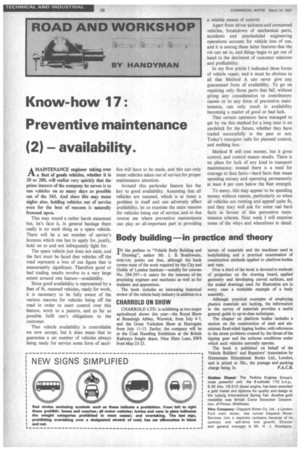Know-how 17: Preventive maintenance (2) — availability.
Page 40

If you've noticed an error in this article please click here to report it so we can fix it.
AMAINTENANCE engineer taking over a fleet of goods vehicles, whether it is 20 or 200, will realize very quickly that the prime interest of the company he serves is to run vehicles on as many days as possible out or the 365. And since this may mean nights also, holding vehicles out of service even for the best of reasons is naturally frowned upon.
This may sound a rather harsh statement but, let's face it, in general haulage there really is no such thing as a spare vehicle. There will be a set number of carrier's licences which one has to apply for, justify, hold on to and not infrequently fight for.
The spare vehicle just does not exist, and the fact must be faced that vehicles off the road represent a loss of use figure that is measureably significant. Therefore good or bad trading results revolve to a very large extent around one feature—availability.
Since good availability is represented by a fleet of fit, manned vehicles, ready for work, it is necessary to be fully aware of the various reasons for vehicles being off the road in order to exert control over this feature, work to a pattern, and as far as possible fulfil one's obligations to the customer.
That vehicle availability is controllable we now accept, but it does mean that to guarantee a set number of vehicles always being ready for service some form of sacri
fice will have to be made, and this can only mean vehicles taken out of service for proper maintenance attention.
Around this particular feature lies the key to good availability. Assuming that all vehicles are manned, which is at times a problem in itself and can adversely affect availability, let us examine the main reasons for vehicles being out of service, and in due course see where preventive maintenance can play an all-important part in providing a reliable means of control.
Apart from driver sickness and unmanned vehicles, breakdown of mechanical parts, accidents and unscheduled engineering operations account for vehicle loss of use, and it is among these latter features that the rot can set in, and things begin to get out of hand to the detriment of customer relations and profitability.
In my first article I indicated three forms of vehicle repair, and it must be obvious to all that Method A can never give any guaranteed form of availability. To go on repairing only those parts that fail, without giving any consideration to contributory causes or to any form of preventive maintenance, can only result in availability becoming a matter of good or bad luck.
That certain operators have managed to get by via this method for a long time is no yardstick for the future, whether they have traded successfully in the past or not. Today's transport calls for planned control, and nothing less.
Method B will cost money, but it gives control, and control means results. There is no place for luck of any kind in transport maintenance; instead there is a need for courage to face facts—hard facts that mean spending money and operating permanently at least 4 per cent below the fleet strength.
To many, this may appear to be spending money without reason, particularly so when all vehicles are running and appear quite fit, and they may well ask for some real hard facts in favour of this preventive maintenance scheme. Next week I will examine son-le of the whys and wherefores in detail.








































































































